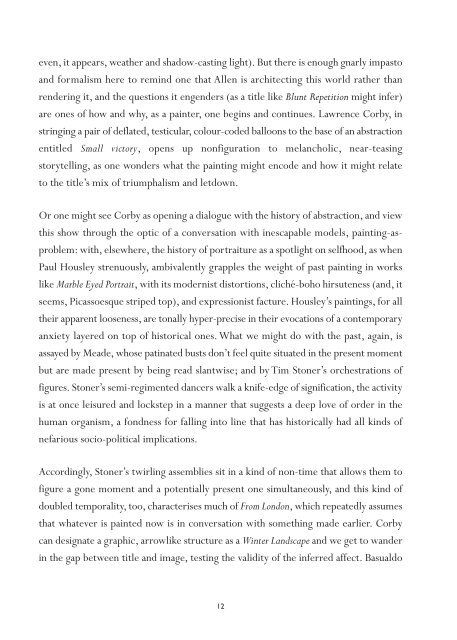Untitled - Damien Meade
Untitled - Damien Meade
Untitled - Damien Meade
You also want an ePaper? Increase the reach of your titles
YUMPU automatically turns print PDFs into web optimized ePapers that Google loves.
even, it appears, weather and shadow-casting light). But there is enough gnarly impasto<br />
and formalism here to remind one that Allen is architecting this world rather than<br />
rendering it, and the questions it engenders (as a title like Blunt Repetition might infer)<br />
are ones of how and why, as a painter, one begins and continues. Lawrence Corby, in<br />
stringing a pair of deflated, testicular, colour-coded balloons to the base of an abstraction<br />
entitled Small victory, opens up nonfiguration to melancholic, near-teasing<br />
storytelling, as one wonders what the painting might encode and how it might relate<br />
to the title’s mix of triumphalism and letdown.<br />
Or one might see Corby as opening a dialogue with the history of abstraction, and view<br />
this show through the optic of a conversation with inescapable models, painting-asproblem:<br />
with, elsewhere, the history of portraiture as a spotlight on selfhood, as when<br />
Paul Housley strenuously, ambivalently grapples the weight of past painting in works<br />
like Marble Eyed Portrait, with its modernist distortions, cliché-boho hirsuteness (and, it<br />
seems, Picassoesque striped top), and expressionist facture. Housley’s paintings, for all<br />
their apparent looseness, are tonally hyper-precise in their evocations of a contemporary<br />
anxiety layered on top of historical ones. What we might do with the past, again, is<br />
assayed by <strong>Meade</strong>, whose patinated busts don’t feel quite situated in the present moment<br />
but are made present by being read slantwise; and by Tim Stoner’s orchestrations of<br />
figures. Stoner’s semi-regimented dancers walk a knife-edge of signification, the activity<br />
is at once leisured and lockstep in a manner that suggests a deep love of order in the<br />
human organism, a fondness for falling into line that has historically had all kinds of<br />
nefarious socio-political implications.<br />
Accordingly, Stoner’s twirling assemblies sit in a kind of non-time that allows them to<br />
figure a gone moment and a potentially present one simultaneously, and this kind of<br />
doubled temporality, too, characterises much of From London, which repeatedly assumes<br />
that whatever is painted now is in conversation with something made earlier. Corby<br />
can designate a graphic, arrowlike structure as a Winter Landscape and we get to wander<br />
in the gap between title and image, testing the validity of the inferred affect. Basualdo<br />
12


